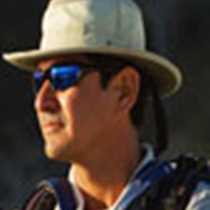North Seymour and Rabida Islands
What a wonderful day we had.
Early in the morning disembarked on North Seymour, a small island located in the middle of the archipelago and, yes, full of life.
Today we had close encounters with blue-footed boobies as they performed the famous “booby dance,” a mating ritual displaying an array of sounds and moves to reinforce a possible long-term relationship by booby standards—four to five months. Frigatebirds also have an impressive mating ritual as they show a huge red gular pouch and stretch their wings while calling to their possible partners.
Our ever-present friends, the sea lions, were impressive as mommies nursed their young right in front of us, oblivious to our presence.
Marine and land iguanas, endemic to the Galápagos, were found basking in the little sunlight we now have.
Today we had two snorkeling outings and both were fantastic and inspiring: sharks, sea lions, turtles and many colorful fish were sighted by our guests. Our water temperature remains in the low 70s, which is great news as it means that molecules are closer together, holding nutrients and therefore more marine biota for us to enjoy.
Rabida Island is always out of the ordinary, just by nature of its bright rust-red color, which was our background for the afternoon’s walk surrounded by prickly pears with peculiar trunks and small terrestrial birds like the Galápagos flycatcher, Darwin finches and a yellow warbler.
The sun sets as it pierces through our inversion layer, which is a sheet of thin clouds, reminding us that even though we’re on the equator, the Galápagos are not typical tropical islands.
At the end of the day, our guests are back on board, sharing the excitement about their adventures. We are becoming a mega-family; uniting families and guests by happiness and common accomplishment.
Tomorrow we are headed to the western part of the archipelago, the land of volcanoes; we can’t wait to share more about our Galápagos expedition.




